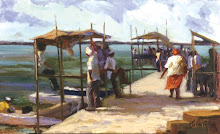The dock at Dunmore Town is a poured concrete runway, fifty-feet long. At the end of the runway is a platform for storage, a pastel green, stucco warehouse, an empty red telephone booth. Old white-side-wall automobile tires line the outer edge of the platform and runway to which boats are tied in random order like trail horses on a tether line; some twelve-foot Whalers next to twenty-five foot water taxis, waiting to take tourists to the North Eleuthera airport. Black Children scurry from tourist to tourist helping with luggage, receiving their tip then scurrying off behind a deserted old refrigerator where they will count their fortune.
Two different species of human’s here: white tourists in pastels from Abercrombie and J.Crew, and purple/black islanders in blacks and browns with bare feet like elephant hide—black with deep pores and scratches that tell stories like the rings of a tree.
An old man with a graying, kinky beard rides a broken-down bicycle around the storage building at the end of the pier, chasing three young children from piles of lumber brought from the mainland. He warns them of the dangers of falling as he slowly weaves in and out of the piles on his bike like an old bumblebee among flowers.
“Hey, chiles. Get-offa-dat wood fo you fall an huht yosef. Gwan now, get!”
From this fifty-foot runway sticking into the harbor, I turn and see the town, a series of quaint, wood-frame homes, mostly white with varying pastel shades of pink or green or blue or violet. Yellow, too. That these homes were first constructed in the early 1800’s is a testament to their hardiness. “You see all dose houses got the same wide siding, everone on Bay Street’s the same, they all built one fashion. The man founded the plan and everbody built the houses alike.” Made of pine from the Abacos and Key West then painted every other year for a hundred and fifty years. Seventy coats of paint resist the hurricane season and bond to each other like left-handedness in a family. This tiny Bahamian community, steadfastly adhering to its New England architecture, remains committed to a sense of values that, too, are under attack from the off-shore social elements—disrespect, petty crime and greed.



No comments:
Post a Comment